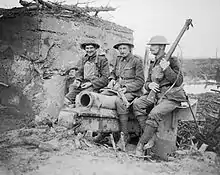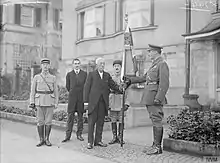Guards Division (United Kingdom)
The Guards Division was an infantry division of the British Army that was formed in the Great War in France in 1915 from battalions of the Guards regiments from the Regular Army. The division served on the Western Front for the duration of the First World War. The division's insignia was the "All Seeing Eye".
| Guards Division | |
|---|---|
 | |
| Active | August 1915 – 29 April 1919 12 June 1945 – January 1947 |
| Country | |
| Branch | |
| Type | Infantry |
| Role | Heavy infantry |
| Size | Division |
| Patron | King George V |
| Engagements | |
| Commanders | |
| Notable commanders | Earl of Cavan |
There was also a Guards Division in the Second World War which was formed on 12 June 1945 from the Guards Armoured Division which had undergone reorganisation.
History
Formation
In July 1915, during the First World War (1914–1918), George V approved the formation of a Guards Division and in August 1915 the division was formed at Lumbres, near St Omer, France.[1]
The 4th (Guards) Brigade was transferred complete from the 2nd Division and redesignated as the 1st Guards Brigade; the 2nd Guards Brigade was formed with two battalions from England and two more transferred from 1st (Guards) Brigade, 1st Division; and the 3rd Guards Brigade likewise with two more battalions from England and two transferred from 20th Brigade, of the 7th Division. Soon after formation, each brigade formed a machine gun (M.G.) company of 16 machine guns, and between March and May 1916 each brigade was also provided with a Trench Mortar (T.M.) Battery of eight 3" Stokes Mortars.[2]
The division was provided with three artillery brigades[lower-alpha 1] – LXXIV, LXXV and LXXVI Brigades, RFA each of four batteries of four 18 pounder guns – from the 16th (Irish) Division[7] and a howitzer brigade – LXI (Howitzer) Brigade, RFA of four batteries of four 4.5" howitzers – from the 11th (Northern) Division which remained in England when the division was posted to Gallipoli.[6] 16th (Irish) Division also provided the Divisional Ammunition Column, two field companies of Royal Engineers and the signal company (Royal Engineer Signals Service).[7] The third field company joined from 7th Division. The pioneers were the 4th Battalion, Coldstream Guards which joined from England on 18 August.[2]
War service
In 1915, the Guards Division took part in the Battle of Loos (26 September – 8 October) and Hohenzollern Redoubt (18 – 19 October). In 1916, it fought in the later stages of the Battle of the Somme, in particular the Battle of Flers–Courcelette (15 – 16 and 20 – 22 September), the Battle of Morval (25 – 28 September), and the Capture of Lesboeufs (25 September). In 1917, it saw action in the Battle of Passchendaele (or the Third Battle of Ypres) including the Battle of Pilckem Ridge (31 August – 2 July), the Battle of Poelcappelle (9 October), and the First Battle of Passchendaele (12 October). It then took part in the Battle of Cambrai (24 November – 3 December).[1]

In February 1918, British[lower-alpha 2] divisions on the Western Front were reduced from a 12-battalion to a 9-battalion basis (brigades from four to three battalions).[8] As a result, the 4th Guards Brigade was formed on 8 February 1918 by taking a battalion from each of the brigades:
- 3rd Battalion, Coldstream Guards from 1st Guards Brigade
- 2nd Battalion, Irish Guards from the 2nd Guards Brigade and
- 4th Battalion, Grenadier Guards from the 3rd Guards Brigade.[2]
The 4th Guards Brigade was transferred to the 31st Division at noon on the same day.[9] On 25 February, the pioneer battalion – 4th Battalion, Coldstream Guards – was reorganized from a four-company to a three-company basis.[10]

1918 saw the return of the war of movement. It had to withstand the German Army's Spring Offensive in the First Battles of the Somme (1 – 25 March) then switched over to counter-attack in the Second Battles of the Somme (21 – 23 August), the Second Battle of Arras (26 August – 3 September), the Battles of the Hindenburg Line (12 September – 12 October), and in the Final Advance in Picardy including the battles of the Selle and of the Sambre. Its final action was the Capture of Maubeuge on 9 November.[11] It ended the war with VI Corps in the British Third Army.[12]
Post-war
At the Armistice of 11 November 1918, the division was in and around Maubeuge, and on 17 November it regained 4th Guards Brigade which was broken up and the battalions returned to their original brigades. The next day it began the march on Germany and crossed the frontier on 11 December. By 19 December it had reached the Cologne area. Units started returning to England on 20 February 1919 and the last had completed the move by 29 April.[11]
Second World War
The Guards Division was reformed during the Second World War on 12 June 1945 by the reorganization and redesignation of the Guards Armoured Division.[13] The division retained all of its original units,[14] but with some changes:
- 5th Guards Armoured Brigade (three armoured battalions and one motorized infantry battalion) was converted to infantry as 5th Guards Brigade[15][16]
- 32nd Guards Infantry Brigade remained unchanged except that 2nd Battalion, Welsh Guards (originally the reconnaissance unit of the Guards Armoured Division[14]) was converted to infantry[17] and joined the brigade[18]
- 2nd Household Cavalry Regiment was transferred from XXX Corps on 12 June 1945 as the new reconnaissance unit[19]
- 6th Guards Tank Brigade (three tank battalions) was converted to infantry as 6th Guards Brigade and joined the division on 19 June[20][21]
- 92nd (5th London) Field Regiment, Royal Artillery joined the division on 12 June from 5th Infantry Division as the third field artillery regiment to match three infantry brigades[22][23]
Major-General Sir Allan Adair remained in command of the reorganized division.[13][14] In January 1947, the division was disbanded.[24]
Orders of battle
| Orders of Battle – August 1915, November 1918, June 1945 | ||
|---|---|---|
| ||
1st Guards Brigade
|
Royal Artillery
|
Mounted Troops
Pioneers
Medical Guards Divisional Train, ASC
|
2nd Guards Brigade
| ||
3rd Guards Brigade
| ||
|
| ||
1st Guards Brigade
|
Royal Artillery
|
Royal Engineers
Pioneers
Machine Gunners
Medical
Divisional Employment Company
Guards Divisional Train, ASC
|
2nd Guards Brigade
| ||
3rd Guards Brigade
| ||
1945
Order of battle when reformed from the Guards Armoured Division, June 1945[13]
- 1st Battalion, Grenadier Guards[lower-alpha 11]
- 2nd Battalion, Grenadier Guards[lower-alpha 12]
- 1st Battalion, Coldstream Guards[lower-alpha 12]
- 2nd Battalion, Irish Guards[lower-alpha 12]
Royal Artillery
- 55th (Wessex) Field Regiment, Royal Artillery
- 92nd (5th London) Field Regiment, Royal Artillery[lower-alpha 13]
- 153rd (Leicestershire Yeomanry) Field Regiment, Royal Artillery
- 75th Anti-Tank Regiment, Royal Artillery
- 94th Light Anti-Aircraft Regiment, Royal Artillery
Royal Engineers
- 14th Field Company
- 615th Field Company
- 148th Field Park Company
- 11th Bridging Troop
Signals
- Guard Division Signals, RCS[lower-alpha 14]
Reconnaissance
Infantry
- 1st Independent MG Company[lower-alpha 16]
- 4th Battalion, Grenadier Guards[lower-alpha 12]
- 4th Battalion, Coldstream Guards[lower-alpha 12]
- 3rd Battalion, Scots Guards[lower-alpha 12]
32nd Guards Infantry Brigade[18]
- 5th Battalion, Coldstream Guards
- 2nd Battalion, Scots Guards
- 3rd Battalion, Irish Guards
- 2nd Battalion, Welsh Guards[lower-alpha 17]
Notable members
2nd Lieutenant Jack Kipling, son of the famous author Rudyard Kipling, served with the Guards Division in France as a platoon commander in the 2nd Battalion, Irish Guards. He was aged just 18, his birthday being only a month before, and was killed in the 1915 Battle of Loos, yet exactly how he died still remains a mystery even nearly 100 years later.
Commanders
The division had the following General Officers Commanding (GOCs):[28][29]
| From | Name | Notes |
|---|---|---|
| 15 August 1915 | Brigadier-General F. J. Heyworth | temporary |
| 18 August 1915 | Major-General Earl of Cavan | |
| 3 January 1916 | Major-General G. P. T. Feilding | |
| 11 September 1918 | Major-General T. G. Matheson | disestablished 1919 |
| 12 September 1942 | Major-General A.H.S. Adair | on re-establishment[lower-alpha 18] |
| December 1945 | Major-General J. C. O. Marriott |
See also
- List of British divisions in World War I
- List of British divisions in World War II
- Guards Division for the administrative formation
Notes
- The basic organic unit of the Royal Artillery was, and is, the Battery.[3] When grouped together they formed brigades, in the same way that infantry battalions or cavalry regiments were grouped together in brigades. At the outbreak of the First World War, a field artillery brigade of headquarters (4 officers, 37 other ranks), three batteries (5 and 193 each), and a brigade ammunition column (4 and 154)[4] had a total strength just under 800 so was broadly comparable to an infantry battalion (just over 1,000) or a cavalry regiment (about 550). Like an infantry battalion, an artillery brigade was usually commanded by a lieutenant colonel. These figures refer to brigades of three 6-gun batteries; artillery brigades of Kitchener's Army were reorganized on a four 4-gun basis in January and February 1915,[5][6] so strengths would be approximately unchanged. Artillery brigades were redesignated as regiments in 1938.
- As distinct from the Australian, Canadian and the New Zealand divisions which remained on a 12-battalion basis.
- Sixteen 18 pounder guns.[25]
- Sixteen 4.5" howitzers.[25]
- Arrived in France 5 August 1915. Broken up 20 June 1916 and held as reinforcements for 1st Life Guards.[2]
- Arrived in France 13 August 1915. Broken up 27 May 1916 and held as reinforcements for 2nd Life Guards and Royal Horse Guards.[2]
- Eight 3-inch Stokes mortars.[27]
- Eighteen 18-pounder guns and six QF 4.5-inch howitzer.[27]
- Six 2-inch Medium Mortars each.[27]
- Formed 1 March 1918 from 1st, 2nd and 3rd Guards Brigade and 4th (Divisional) M.G. Companies.[2]
- Converted from a Motor Battalion.[17]
- Converted from an Armoured Battalion.[17]
- Transferred from the 5th Infantry Division on 12 June 1945.[22][23]
- Redesignated from Guard Armoured Division Signals, RCS.[14]
- Transferred from XXX Corps on 12 June 1945.[19]
- 1st Independent MG Company was formed from the 4th Battalion, Royal Northumberland Fusiliers.[13]
- 2nd Battalion, Welsh Guards was the reconnaissance unit of the Guards Armoured Division.[14] It was converted to infantry[17] and assigned to 32nd Guards Infantry Brigade on 20 June 1945.[18]
- Major-General A. H. S. Adair was in command of the Guards Armoured Division when it was renamed the Guards Division.[14]
References
- Becke 1935, p. 30
- Becke 1935, p. 29
- "The Royal Artillery". Ministry of Defence (United Kingdom). Archived from the original on 23 October 2013. Retrieved 13 April 2013.
- Baker, Chris. "What was an artillery brigade?". The Long, Long Trail. Retrieved 13 April 2013.
- Becke 1938, p. 65
- Becke 1938, p. 23
- Becke 1938, p. 68
- Becke 1935, p. 28
- Becke 1945, p. 16
- Becke 1935, p. 27
- Becke 1935, p. 31
- BEF GHQ 1918, p. 75
- Joslen 1990, p. 34
- Joslen 1990, p. 11
- Joslen 1990, p. 156
- Joslen 1990, p. 236
- Bellis 1994, pp. 40–43
- Joslen 1990, p. 280
- Bellis 1994, p. 10
- Joslen 1990, p. 157
- Joslen 1990, p. 239
- Joslen 1990, p. 47
- Bellis 1995, p. 96
- "Guards Division Disbanded". The Times. No. 50655. London. 10 January 1947. p. 2.
- Becke 1935, p. 126
- BEF GHQ 1918, p. 38
- Becke 1935, p. 127
- Mackie, Colin (9 January 2015). "Army Commands 1900-2011" (PDF). www.gulabin.com. p. 183. Archived from the original (PDF) on 5 July 2015. Retrieved 15 April 2015.
- Becke 1935, p. 25
Bibliography
- Becke, Major A. F. (1935). Order of Battle of Divisions Part 1. The Regular British Divisions. London: HMSO. ISBN 978-1-871167-09-2.
- Becke, Major A. F. (1938). Order of Battle of Divisions Part 3A. New Army Divisions (9–26). London: HMSO. ISBN 978-1-871167-08-5.
- Becke, Major A. F. (1945). Order of Battle of Divisions Part 3B. New Army Divisions (30–41) & 63rd (RN) Division. London: HMSO. ISBN 978-1-871167-08-5.
- Bellis, Malcolm A. (1994). Regiments of the British Army 1939–1945 (Armour & Infantry). London: Military Press International. ISBN 978-0-85420-999-6.
- Bellis, Malcolm A. (1995). Regiments of the British Army 1939–1945 (Artillery). London: Military Press International. ISBN 978-0-85420-110-5.
- Headlam, Cuthbert (2010) [1924]. History of the Guards Division in the Great War, 1915–1918. Vol. I (repr. Naval & Military Press, Uckfield ed.). Edinburgh: John Murray. ISBN 978-1-84342-124-5.
- Headlam, Cuthbert (2010) [1924]. History of the Guards Division in the Great War 1915–1918. Vol. II (repr. Naval & Military Press, Uckfield ed.). London: John Murray. ISBN 978-1-84342-124-5.
- Joslen, Lt-Col H. F. (1990) [1st. Pub. HMSO:1960]. Orders of Battle, Second World War, 1939–1945. London: London Stamp Exchange. ISBN 978-0-948130-03-8.
- Order of Battle of the British Armies in France (including Lines of Communication Units) and Order of Battle of the Portuguese Expeditionary Force. France: General Staff, GHQ. 1918. OCLC 74447069.
External links
- Baker, Chris. "The Guards Division". The Long Long Trail. Retrieved 8 April 2015.
- Guards Division on The Regimental Warpath 1914 - 1918 by PB Chappell at the Wayback Machine (archived 15 February 2013)
- "Guards Division". Orders of Battle.com.